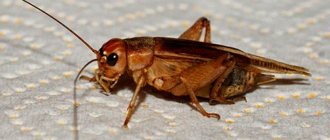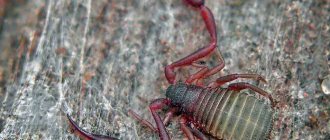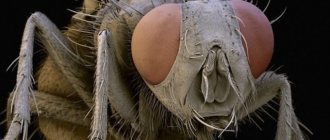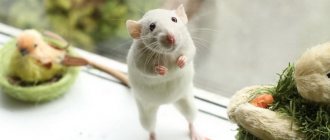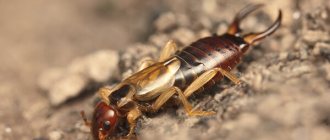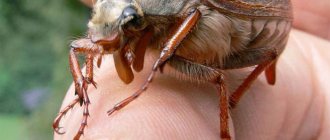Breeding crickets at home from your own experience.
If you are a lover of everything original, this pet is for you.
True, the duration of its life cycle is not very long, even with proper maintenance. They live no more than a few months. So, you shouldn’t get too attached to your pets. In addition, this is a rather noisy creature, but if you want to listen to the songs of crickets, you can try it. Considering the volume of clutches and the frequency of reproduction, your population will soon increase greatly. But if you consider crickets as live food (if you are not against this approach) for other pets (spiders, lizards, frogs), this will suit you quite well.
Video about keeping crickets
Today we talked about keeping crickets at home. We would be interested to know your opinion - can a cricket be a pet? Perhaps someone even has experience keeping these creatures at home, please share it with us.
Probably every owner of an insectivorous animal sooner or later thinks about obtaining food at home. For the first time, faced with the fact that sometimes live food was simply not available, we tried to start breeding crickets ourselves. In practice, this turned out to be not as simple as they say in books and on forums, but through trial and error you can achieve good results.
The main thing is desire and patience. Knowing how to properly keep and care for crickets, breeding will not be difficult over time. To do this, you need to place a small container 4-5 cm deep filled with a soft, moist substrate in a cage with adult crickets: vermiculite, soil, peat, sand - everything can be mixed in any proportions or separately, females can lay eggs anywhere, even in wet food ).
It is advisable to cover the container with a fine mesh net to prevent adult insects from eating their larvae. If you are not striving for an industrial scale, then let them eat, they won’t eat everything, and the nutritional benefit from this for the crickets themselves will be considerable. There should be more females than males (for 3-4 females there is 1 male), otherwise the latter will not melodiously “sing” to attract the female, but will fight or loudly “drive away” other male competitors.
Adults live for about 2-4 weeks. All this time, the males sing, and the females intensively (in portions of 2-5 pieces) lay eggs in the substrate; one clutch ranges from 350 to 900 eggs, depending on the type of cricket. After one to two weeks, depending on the temperature (the higher, the faster), the babies will hatch, the so-called “cricket dust” measuring 1-2mm.
Over the course of two to three months, they will grow and molt periodically until they reach sexual maturity. Also, the entire life cycle of a cricket depends on temperature - the warmer it is, the faster its growth and development. If you do not want the dust to hatch in the same cage, remove the container with the eggs to another warm place with the proper conditions described above.
This way you can avoid larger crickets from eating smaller ones and keep the crickets relative to their size. It is advisable to have at least three cages. Remember about the life cycle of crickets and try to make sure that a new generation always grows in time to replace the old generation, then you will never have any shortages of food.
You can ask for information of interest and discuss the article at the following link: Forum about geckos
Crickets are grown in two cases - as “singers” and as live food for other pets.
It is quite easy to keep warblers in a container made of any material. The most convenient dimensions are 60x40 cm with a height of 30 cm. The bottom is covered with sawdust. There must be sticks, twigs and any other objects on which insects will climb and where they will hide.
Caring for insects consists of:
- maintaining the microclimate in the insectarium,
- cleaning it,
- and feeding pets.
We suggest you read: How to fight aphids on house flowers
Many insect owners are faced with the question: what do crickets eat in their natural habitat? Let’s find out.
In an insectarium, as in nature, they eat everything - leftover fruits, vegetables, bread crumbs, oatmeal, various whiskeys, dry baby food will do. You can even give sweet corn sticks.
Lettuce leaves, burdock leaves, and tops of garden plants are very suitable as a source of plant fiber. In the summer you can put grass in the insectarium - crickets readily eat it.
To enrich the diet with proteins, you can use dry gammarus, egg white, and fish meal. But you can’t overfeed with such food! This undermines the health of insects, complicates molting, and causes softness of the chitinous covers.
The success of cricket breeding depends on how successfully the conditions were created and the maintenance was organized. Insects must receive enough nutrition and be in an environment close to their natural habitat. In this case, you can expect the crickets to lead an active lifestyle and increase their population. If the conditions are unsuitable, then pets can even kill each other.
Ideally suited for home maintenance:
- House crickets are the most common species in captivity. They are small in size and are most often bred for food. With the onset of evening and until morning they can emit ringing trills.
- Banana. The species is characterized by a high reproduction rate and love of warmth.
- Two-spotted. A dry microclimate and relatively low air temperature suit them: 23° C will be quite enough for insects.
The two-spotted cricket is larger than the house cricket: its body can reach 3 cm
Keeping crickets involves paying attention to the characteristics of each species. But there are also general recommendations that are universal in any situation.
Container
The first step is to take care of the container for growing crickets. Any container made of plastic, glass or chipboard can serve as an insectarium. The main thing is that its area is at least 60x40 cm, and its height is more than 30 cm. In such a space, insects will feel comfortable.
People who know first-hand how to breed crickets at home advise placing boxes with cells intended for eggs on top of each other in the cage. This trick increases the useful area, and the number of pets will increase. In addition, the cells remind crickets of burrows - shelters that they dig in life in the wild.
To illuminate the container, incandescent lamps with a power of 25 to 40 W are used. They will not only create light, but also be a source of heat. A 16-hour daylight period is sufficient for crickets to thrive.
Microclimate
The microclimate suitable for crickets consists of two important indicators:
- The optimal temperature depends on the species. For example, the heat-loving banana cricket does well when it is above 26°C, although it would prefer a reading between 28°C and 37°C. For house and two-spotted crickets, a temperature of 23 °C is suitable. The higher the air temperature, the better the health of chirping pets and the more intensive their growth. But at the same time they need more food and more frequent bedding changes.
- Air humidity should be at least 40–50%. This value is especially important for cricket eggs, which can simply die in dry soil. Therefore, the substrate with masonry must be constantly moistened. If the humidity is too high, then mites will appear in the insectarium, and this will mean the possible death of the crickets.
Once suitable conditions have been created, the first residents can be allowed into the container.
If the air temperature rises above 45° C, the insect dies.
The house cricket (Acheta domestica) is the most common species of forage cricket. Adults reach a length of 25 mm, have well-developed jumping limbs and antennae 30 mm long. The color of the house cricket is light or dark brown with a dark stripe between the eyes. Both males and females have long wings, but crickets rarely fly.
Keeping crickets To keep crickets, use a container whose minimum height should be 40 cm, which will prevent the crickets from jumping out when the lid is lifted. The lid is made of durable material; to ensure ventilation, it is better to use a metal mesh with small cells.
We invite you to read: How to get rid of nits on long, medium and short hair at home, in 1 day, without combing, in adults and children
Small cells will not allow crickets to escape, and they will not be able to chew through metal. The edges of the lid can be strengthened with silicone gel so that it fits more tightly to the walls of the container. The temperature should be quite high - about 30 ° C. Heat mats, cords, or lamps can be used to maintain a high temperature in the cricket container.
At low temperatures, the growth and development of crickets slows down. So, at room temperature, the maturation of eggs takes 2-3 months, and the formation of an adult after 13 larval stages takes 5-8 months. At a temperature of 30°C, eggs mature in 10 days, and crickets mature in just 7 stages within a month. Humidity should be 50-70%.
Types of crickets and creating the necessary conditions for them
The success of cricket breeding depends on how successfully the conditions were created and the maintenance was organized. Insects must receive enough nutrition and be in an environment close to their natural habitat. In this case, you can expect the crickets to lead an active lifestyle and increase their population. If the conditions are unsuitable, then pets can even kill each other.
Ideally suited for home maintenance:
- House crickets are the most common species in captivity. They are small in size and are most often bred for food. With the onset of evening and until morning they can emit ringing trills.
- Banana. The species is characterized by a high reproduction rate and love of warmth.
- Two-spotted. A dry microclimate and relatively low air temperature suit them: 23° C will be quite enough for insects.
The two-spotted cricket is larger than the house cricket: its body can reach 3 cm
Keeping crickets involves paying attention to the characteristics of each species. But there are also general recommendations that are universal in any situation.
Over time, a person who keeps crickets at home can draw conclusions and develop his own rules based on experience and observation.
Container
The first step is to take care of the container for growing crickets. Any container made of plastic, glass or chipboard can serve as an insectarium. The main thing is that its area is at least 60x40 cm, and its height is more than 30 cm. In such a space, insects will feel comfortable.
People who know first-hand how to breed crickets at home advise placing boxes with cells intended for eggs on top of each other in the cage. This trick increases the useful area, and the number of pets will increase. In addition, the cells remind crickets of burrows - shelters that they dig in life in the wild. For young individuals that have recently been born, crumpled paper is suitable. Dry fish food mixed with oatmeal, peat, sand, and bran is suitable as a primer. But you don’t have to pour it in.
You need to clean the cage at least once a week. Dirt and waste products of crickets inhibit reproduction and are a substrate for parasitic mites.
To illuminate the container, incandescent lamps with a power of 25 to 40 W are used. They will not only create light, but also be a source of heat. A 16-hour daylight period is sufficient for crickets to thrive.
Microclimate
The microclimate suitable for crickets consists of two important indicators:
- The optimal temperature depends on the species. For example, the heat-loving banana cricket does well when it is above 26°C, although it would prefer a reading between 28°C and 37°C. For house and two-spotted crickets, a temperature of 23 °C is suitable. The higher the air temperature, the better the health of chirping pets and the more intensive their growth. But at the same time they need more food and more frequent bedding changes.
- Air humidity should be at least 40–50%. This value is especially important for cricket eggs, which can simply die in dry soil. Therefore, the substrate with masonry must be constantly moistened. If the humidity is too high, then mites will appear in the insectarium, and this will mean the possible death of the crickets.
Once suitable conditions have been created, the first residents can be allowed into the container.
Feeding frequency
In the wild, the cricket feeds on pieces of plants, small insects, and dead arthropods. Some individuals do not disdain cannibalism and destruction of the clutches of their relatives. But what to feed crickets at home?
When kept in captivity, the following is suitable food for crickets:
- finely chopped vegetables and fruits;
- greens, tops, burdock and dandelion leaves;
- milk in powder form, including infant formula;
- oatmeal and bran;
- food for cats and dogs;
- boiled chicken egg;
- boiled lean meat.
A very important component of a cricket's diet is protein. If there is not enough of it, the insects will begin to eat each other. Females that feed only on plant foods lay eggs that will soon die. And the life expectancy of adults will be much shorter. Therefore, it is necessary to add fishmeal, egg whites and gammarus, which is used to feed aquarium fish.
How to water crickets? Some experts suggest installing a drinking bowl, but this is not entirely safe: young individuals drown in them, females lay eggs, and it’s quite easy to turn it over. Another option - spraying one corner with a spray bottle - entails a persistent increase in humidity, and, as a result, the appearance of mites.
The simplest drinking bowl for crickets: fabric constantly moistened with water from a vessel
Dry food should be present to insectaries at all times.
To avoid rotting, it is better to give succulent food (carrots, apples, cabbage, rutabaga) 1-2 times a day, after grating it on a coarse grater. A small portion, placed on a bowl, is left in the insectarium for an hour to an hour and a half, and then removed. At the next feeding, a new batch of grated feed is prepared. The same goes for pieces of meat.
Cricket lifestyle
Crickets belong to the suborder Longwhiskers, order Orthoptera and number more than 2000 species. They are able to adapt well to environmental conditions, feeling comfortable both in the hot, humid tropics and in practically barren, dry areas.
The house cricket, Acheta domestica, lives naturally in the desert areas of North Africa, where water is available only in the form of dew drops and there is virtually no vegetation. What do crickets eat in the wild? In such modest conditions, the desert inhabitant does not disdain anything; he feeds on the organic remains found, even those that have long dried up.
Persistently digging in the sand, it looks for eggs, larvae and pupae of other insects. At home, in dark basement corners or under the floor of a hut, the cricket behaves the same way and actively destroys flea nests and cockroach broods. What do crickets eat at home?
Reproduction
Reproduction of crickets occurs when the insects create comfortable conditions and an abundance of food. In a population, there must be at least 4 females per 1 male, otherwise deadly struggles and deafening crackling are guaranteed. A small container (4 cm deep) is placed in the container, into which wet peat, sand or plain soil is placed.
Raising crickets at home is a fairly simple task. The main thing is to create suitable conditions - temperature, humidity and refreshment, and then give your pets the required amount of food: dry and wet. Females are quite undemanding to conditions, so very soon the population will begin to rapidly increase.
Appearance
The house cricket resembles a massive, medium-sized grasshopper with a straight back.
- Ordinary grasshoppers have folded wings. Crickets have three pairs of legs. The latter, like that of grasshoppers, is long and can push the house cricket upward. But he doesn't use his "catapult" to make jumps. The insect needs this pair of paws only to throw its body up, where it can spread its wings for flight.
- Crickets fly very well.
- The cricket's singing mechanism, also located on its hind legs, gives it an additional resemblance to a grasshopper.
- The head is large. There is a pair of large compound eyes on it.
- The mouthparts are gnawing type.
The long cerci located at the end of the abdomen give the house cricket its terrifying appearance. They are associated with stings. But house crickets are harmless insects. The female has a long (11-15 mm) ovipositor between the cerci. The cricket's body length is 1.5-2.5 cm. The color of the cricket's body varies from yellowish to brown.
A photo of a house cricket taken from above gives an idea of what this human companion looks like.
Lifestyle
Crickets are active at night. This is the song beloved by many that males produce when courting a female or scaring off rivals. During the day they hide in secluded places. In summer, insects prefer a natural habitat, hiding in damp crevices or burrows.
We suggest you read: What does a house cricket look like?
Females lay eggs in moist substrate in crevices of trees or stones. The number of eggs laid by one female per season depends on the ambient temperature. The usual number is from 40 to 180, but at temperatures above 28°C the number of eggs laid can exceed 700.
For the winter, crickets move into houses and into warm, damp rooms, which include heated basements and heating power lines. When the air temperature is above 21°C, the cricket in the house can continue its vital activity in winter.
Relationships with a person
A very difficult topic for cricket. In Japan, it was customary to keep these insects at home in miniature cages. In Asia they are specially bred for food; in North America they are used as bait. In Russia today, many exotic animal lovers keep reptiles that eat crickets. Owners of these cold-blooded animals, along with reptiles, usually breed crickets as food for their pets.
If a cricket suddenly appears in a multi-storey building in the city center, you can be sure that it has escaped from a pet reptile lover. Much less often such escapes occur from insect lovers due to the fact that they also prefer to keep exotic crickets.
How to get rid of house "guests"?
The presence of these insects at home is a bad sign. They create a lot of noise and simply keep you awake at night. They are masters of camouflage, which also creates additional problems when searching for them. To avoid “settlement”, follow these tips:
- Close all possible paths. They usually enter a home through a cracked window, a crack in the wall, or a hole in the flooring. Check the house and make sure it is airtight.
- Don't litter. Remove crumbs and close the trash can tightly. Eliminating the food source eliminates the cricket problem in general, as does cockroaches.
- Clean up the house. They love piles of paper and other miscellaneous items that might be considered trash.
- Treat the area near the house with pesticides. If the population in the house has reached a critical level, it will not be possible to get rid of them manually. To do this you will have to purchase an insecticide. Treat areas around your doors and windows with it. You can also walk around the perimeter of the foundation. Be sure to check the instructions and directions for use if you have small children or pets.
How to get rid
If a cricket in the house turned out not to be lucky, but to insomnia, and even managed to multiply, you will have to get rid of the uninvited guests. Here it would be appropriate to remember that biologically they are cockroaches with similar requirements for habitat and food. You can poison them with chemicals, set up sticky traps, and try to drive out the crickets with folk remedies. But the first thing to do is to stop “feeding” them:
- There should be no open trash cans, untidy crumbs, or leftover food on the table in the house.
- It is necessary to monitor the taps so that water does not drip from them (watering hole).
- If the house has a basement, you need to check if there are damp places there.
- All cracks through which insects can enter the house must be sealed. Hang a mosquito net on the windows.
For private houses and apartments on the first floors, trimming the green spaces under the windows will be a prerequisite. Owners of a private house need to place compost pits in the farthest corner of the site, since crickets live in nature in just such damp places full of rotting organic matter.
Cricket business: how a Minsk resident runs an insectological farm
A correspondent of the Minsk-News agency met with entrepreneur Sergei Makarov, who is engaged in an unusual business - growing crickets, including for human consumption.
Since childhood, Sergei was partial to all kinds of insects, and even thought about connecting his life with veterinary medicine. But he became a television director, working in his specialty for 12 years. The turning point came when I came across an episode of the program “Dirty Jobs”, where they talked about breeding crickets. And Sergei caught fire. He hatched the idea of organizing his own insectological farm for a year and a half.
— When I returned to Minsk, I bought crickets, started breeding them at home for myself, and studied the market. At that time, there was a good demand for insects to feed exotic animals - hedgehogs, spiders, lizards... But I realized that I did not want to engage in small-scale production. If we take on a task, it will be a large-scale one - growing crickets as food for people. 4-5 years ago there was no talk that insects could become part of the diet of the inhabitants of the European continent, but I was sure that the topic of entomophagy would come up. And now there are reports on TV showing how they bake bread from crickets in Finland,” says Sergei Makarov.
As a new businessman, he faced a number of difficulties. One of them is obtaining veterinary and sanitary standards and regulations for the operation of the farm. At the Minsk regional veterinary station, where the young man turned, they just shrugged their shoulders - there are no such documents. Only six months later he was given a printed article on cricket breeding as a version of the rules and regulations.
“Even today there are no regulations for insect farming. And initially there was not even this type of activity, which is why at first I could not register a company. From January 1, 2021, captive breeding of semi-domesticated or wild animals, reptiles, and insects appeared in the list of types of economic activities. This was a kind of gift to me for the New Year. I was very glad that I was finally able to open a company,” says Sergei.
But he started his business by breeding crickets to feed exotic animals, since it was necessary to test the technology for growing insects.
— Growing insects on an industrial scale is very different from breeding at home. When you have 500 kg of live weight of a cricket per 30 m², the humidity rises instantly, and it is not clear what to do to keep it at the desired level. In the year and a half that the farm has existed, the technology has been radically changed 4 times,” continues the entrepreneur.
There was a demand for feed, but not enough. The farm produced more insects than it could sell.
— Interest in exotic pets has declined. This prompted us to move in the initially intended direction - working for the food industry for people,” notes the innovator.
At some point, Sergei was already thinking about closing the company, but then fortune smiled on him: the demand for crickets went up all over the world. Potential investors from the USA and Russia have appeared, ready to invest in the development of the farm.
“Now we have such a proven technology that we have increased production volumes: from 1 m² we get 10 kg of cricket,” shares the farm owner.
Three types are eaten: black, banana and brownie. The first one is quite large, but it has a thick shell and is good to fry whole. The second one is medium in size and growing quickly. House crickets are bred on Sergei's farm. It is small and easier to dry for flour.
— The shell is the protection of the insect. Drying a large cricket is an energy-consuming task, which affects the final cost of production,” explained S. Makarov.
Insects live on shelves in containers where egg trays are located - this provides additional area for their habitat. In one such house there are up to 30,000 (10 kg) residents.
Crickets are polyphagous; their diet contains both plant and animal foods. Insects feed on proprietary feed based on bran.
“With such a density of living, they begin to engage in cannibalism. A cricket that molts will be eaten by its fellows without hesitation. To maintain their numbers, they need to be given a sufficient amount of protein in addition to plant components, explains the farm owner.
Insects are fed once a day; they need 20-30 kg of feed and water.
The population is growing rapidly. One female lays 200 eggs. But the masonry still needs to be preserved. One fly can destroy half the offspring of crickets.
— Cricket larvae hatch after 10 days, and flies after 1-2. They can easily eat half the clutch. It’s the same story with midges,” Sergei Makarov describes the nuances of insect breeding.
The crop is harvested every month - this is how long it takes for crickets to grow from an egg into an adult insect. For this process to continue continuously, optimal temperature and humidity are needed. If there should be more heat (the growth rate of the cricket depends on this), then less humidity (since it prevents them from molting).
Harvesting involves placing the crickets in the freezer.
In addition to flour, cricket can be used to make a whole line of products - carbohydrate and protein bars, sports nutrition supplements, mixtures for baking bread, pancakes...
As for flour, the entrepreneur considers Russia, Ukraine, and China as promising markets. But to work with Asians, you need large volumes of production (5 tons of products, which is 20 tons of crickets) and money for marketing.
In addition, the company is preparing to launch the production of cookies with the addition of cricket flour.
— In 5 years, I see my enterprise as a holding company, where there will be the production of flour, fertilizer from cricket meconium, pharmacological preparations and other areas. You can get 15 components from crickets, which are valuable in themselves, and build a business on this,” the Minsk resident shares his plans for the future.
Sergei also wants to build his own building for the farm, which is currently located on rented premises:
“We’ve had to move several times already. Re-adapt the premises for production: install heated floors, install climate control. After which the landlord realized that he had excellent space and raised the rent. We can’t just pack our things and leave. This is fraught with loss of population and failure to fulfill obligations to consumers. We will build our building to meet the conditions we need. It will cost 500 thousand dollars.
Photo from the archive of Sergei Makarov
